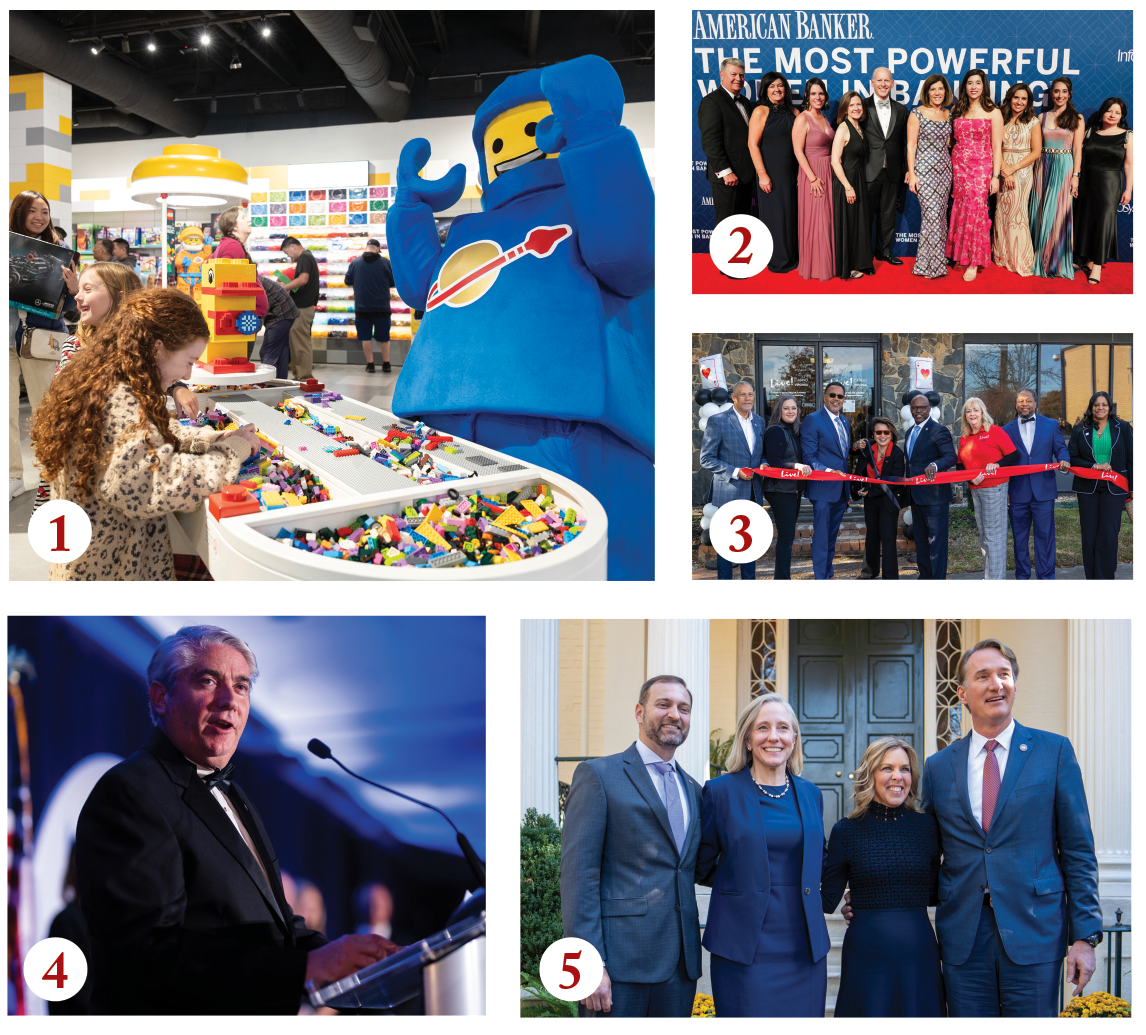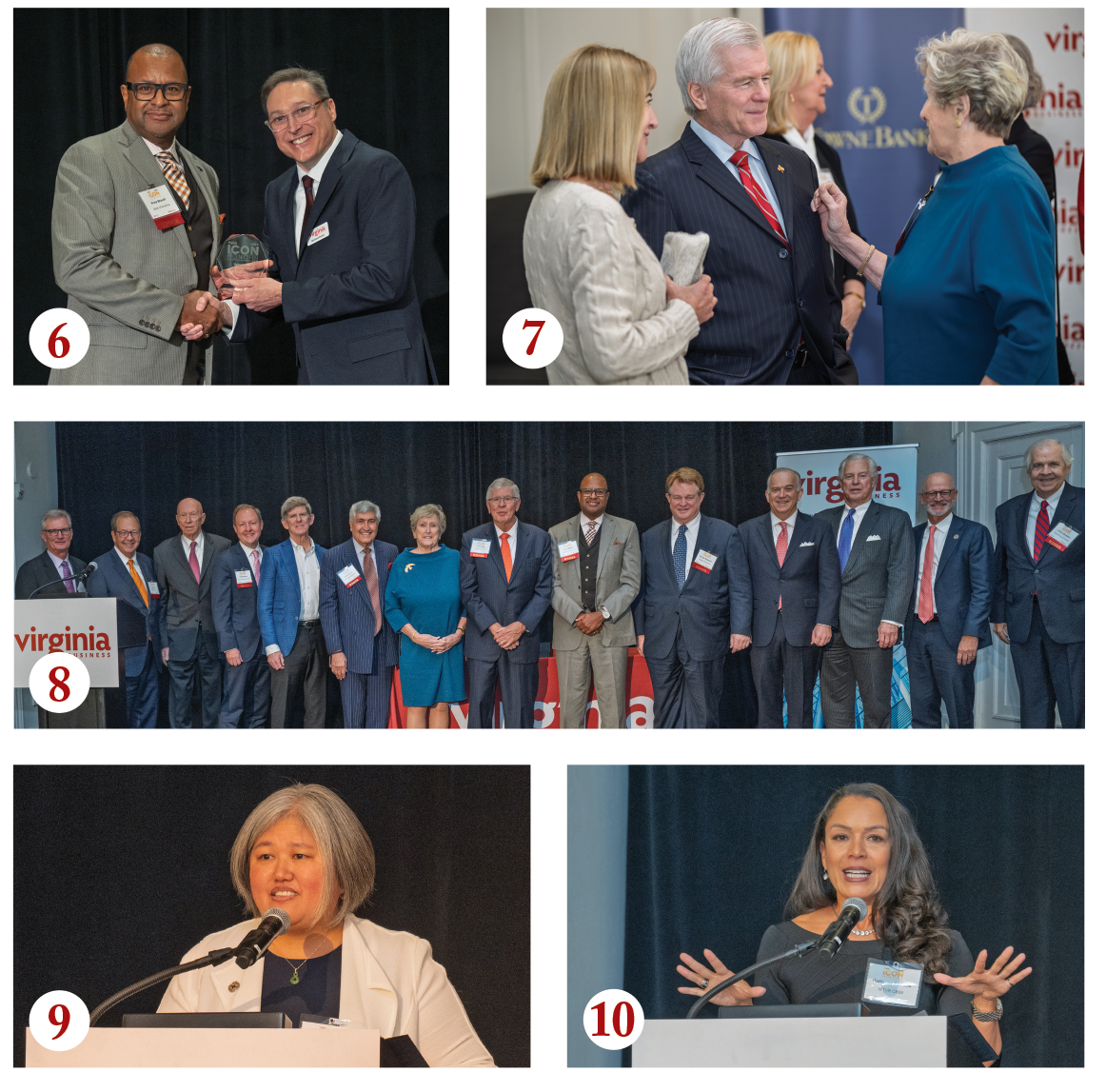Central Virginia
Pharmaceutical giants AstraZeneca, Eli Lilly & Co. and Merck & Co. have committed a cumulative $120 million to develop a workforce training center for advanced pharmaceutical manufacturing in Central Virginia. The companies, each of which plans to build major manufacturing facilities in Virginia; the state government, including Virginia Innovation Partnership Corp.; and multiple Virginia colleges and universities signed a memorandum of understanding to establish the Virginia Center for Advanced Pharmaceutical Manufacturing. Gov. Glenn Youngkin signed the MOU at an event announcing the partnership on Oct. 31. (VirginiaBusiness.com)
Billionaire Pittsburgh Steelers minority owner Rob Citrone and his wife, Cindy, are donating more than $50 million to Hampden-Sydney College — the largest single gift in the school’s 250-year history — to launch a full-tuition scholarship program for top prospective students. The Citrone Scholars Program will offer four-year, merit-based scholarships to help Hampden-Sydney attract and educate more “young men of intellect, character and purpose,” according to an early November news release from the college. Rob Citrone, co-founder of hedge fund Discovery Capital Management, graduated from the college in 1987 and serves on Hampden-Sydney’s board of trustees. (VirginiaBusiness.com)
Utah-based Civica will begin selling a type of long-acting insulin on Jan. 1, 2026, although it will not come from the nonprofit drug maker’s Petersburg facility. Civica has reached a multiyear agreement with Biocon Ltd. subsidiary Biocon Biologics, a pharmaceutical manufacturer headquartered in India, which will manufacture glargine-yfgn insulin in Malaysia under Biocon Biologics’ existing U.S. market approval. The agreement creates an exclusive distributorship arrangement in which Biocon Biologics will manufacture and supply the medicine to Civica, and Civica will distribute, promote and sell the medicine in the U.S. under a separate Civica label and trade dress. (VirginiaBusiness.com)
Following five hours of public comment, the Goochland County Board of Supervisors approved in the early morning of Nov. 7 a technology overlay district plan that will allow the construction of data centers in undeveloped swaths of land in the county’s east end. Goochland currently has no data centers. The district along Route 288 will contain special zoning allowing certain businesses, including a small modular nuclear reactor, a natural gas peaking plant or a utility generating station. It will also require buffers between the buildings and the roads and certain design standards. (Richmond Times-Dispatch)
Amid forecasts of dismal third quarter earnings, Bill Nash is out as president and CEO at national used-vehicle retailer CarMax, even as its chief rival, Carvana, marked record quarterly results. Nash, who led the Goochland County-based Fortune 500 company for close to a decade, is also stepping down from the company’s board as of Dec. 1. CarMax board member David McCreight, who previously served as CEO of online retail platform Lulu’s Fashion Lounge Holdings, has been named interim president and CEO. Former CarMax CEO Tom Folliard, the current board chair, has been named interim executive chair of the board. He served as CarMax’s CEO from 2006 to 2016. (VirginiaBusiness.com)
Billionaire philanthropist MacKenzie Scott gifted $50 million to Virginia State University — the largest gift from a single donor in the school’s 143-year history, the Ettrick university announced Oct. 30. The record donation marks Scott’s second gift to VSU in five years. In 2020, she donated $30 million to the public historically Black land-grant university, which has about 5,000 students. VSU will use the money to “expand its efforts to transform lives through education and continue the mission outlined in the university’s strategic plan,” the university said. (VirginiaBusiness.com)
Eastern Virginia
Amazon opened its massive 3.2 million-square-foot, highly automated fulfillment center in Virginia Beach at the end of September, hiring hundreds of workers to process customer orders alongside robots. According to spokesperson Sam Fisher, more than 700 people have been hired for the new facility on Dam Neck Road, with plans to hire an unspecified number of additional workers. Starting salaries begin at $19 per hour. The five-floor fulfillment center marks the second and final phase of a $350 million expansion in Virginia Beach that included a 219,000-square-foot delivery station, which opened last year at 2201 Harpers Road. (VirginiaBusiness.com)
An energy infrastructure manufacturer focused on data centers has established its first U.S. plant in James City County, a $5.225 million investment, Gov. Glenn Youngkin announced in early November. Dublin, Ireland-based CEL Critical Power‘s new 400,000-square-foot facility will produce power systems that will serve data centers throughout the United States. CEL already has 50 employees at its new facility across engineering, research and development, finance, management and sales. The number of jobs is expected to rise to 250 within the next year and 500 by 2030. CEL has signed a long-term lease on a recently constructed building for the project. (VirginiaBusiness.com)
On Nov. 5, Newport News Shipbuilding laid off 167 employees who had been furloughed earlier this year. A company spokesperson said the decision came “after careful review of our salaried workforce and business needs.” The layoffs mark the latest step in a workforce realignment that began in May, when the company announced plans to furlough 471 salaried shipbuilders for up to five months starting June 2. About a third of the previously furloughed employees had been laid off. Other furloughed shipbuilders returned to NNS during the furlough period, while 99 left the company voluntarily, either through resignations or retirements. (VirginiaBusiness.com)
In a first for Virginia’s gaming industry, workers at Rivers Casino Portsmouth approved a three-year union contract with a 95% yes vote. Represented by Teamsters Local 822, 29 slot attendants at the casino are now the first casino workforce in the state to ratify a collective bargaining agreement. The contract covers pay, locks in employer-paid health care coverage, provides protections from at-will employment and grants additional paid time off. Union leaders, who announced the vote in late October, say the deal will set a precedent for wages and workplace protections as casinos continue to expand across Virginia. (VirginiaBusiness.com)
Virginia Beach wants another major sports venue near the Oceanfront and recently issued a request for proposals seeking a developer to build and operate a sports venue on a 28.6-acre property directly adjacent to the convention and sports centers along 19th Street between Parks Avenue and Birdneck Road. Potential uses for the “action sports facility” include skateboarding, rock climbing, BMX, indoor water and ice sports or other compatible indoor sports uses. The proposed site is currently used for surface parking. Development proposals are due Dec. 5. (VirginiaBusiness.com)
PEOPLE
Langley Federal Credit Union in November announced that Gaurav Bhatia will be its new president and CEO. Bhatia will succeed Tom Ryan, who is retiring at the end of 2025 after 13 years leading the Newport News-based credit union, the fourth largest in Virginia, with $4 billion in assets. Bhatia has more than 20 years of executive experience in financial services, technology and business transformation. He was most recently chief marketing, digital and experience officer at Tysons-based PenFed, the second largest credit union based in Virginia. (VirginiaBusiness.com)
Northern Virginia
McLean-based software company Appian presented arguments in late October before the Supreme Court of Virginia that it should receive a record-breaking $2.04 billion jury award in a trade secrets trial decided in 2022 — a jackpot overturned by three appeals court justices last year. In 2022, Appian won what was estimated to be the largest jury award in Virginia state court history from rival Pegasystems. The state’s high court agreed to hear a petition from Appian to reinstate the judgment, and the company raised four errors it believes the Court of Appeals made. The court also heard Pega’s cross-appeal issues. A ruling is expected in 2026. (VirginiaBusiness.com)
In late October, the Stafford County Planning Commission voted 6-1 to defer requests from Texas retail chain Buc-ee’s for a rezoning and conditional use permit to build a 74,000-square-foot mega travel center in the county off Interstate 95. The matter will be revisited Jan. 14, 2026. The Virginia Department of Transportation made 86 comments on the traffic impact analysis and generalized development plan for the center, causing the planning commission’s chair to ask why the body was considering the application at this time with transportation issues unresolved. Dozens of county residents also spoke, many airing worries about potential noise and pollution in their neighborhoods. (VirginiaBusiness.com)
A future data center campus in western Prince William County has sold for a staggering $700 million, ranking it among the top deals for raw land in U.S. history and proving again there is seemingly no price ceiling for fully entitled data center assemblages. Stanley Martin Homes sold Devlin Tech Park to Amazon Data Services, Amazon.com’s data center arm, according to two sources with knowledge of the deal, which closed Oct. 31. The Bristow site is entitled for up to 3.5 million square feet of data centers and up to three substations. (Washington Business Journal)
Vantage Data Centers plans to invest $2 billion to build a data center campus in Stafford County, Gov. Glenn Youngkin announced Nov. 6. The investment is expected to create 1,100 construction jobs and 50 permanent jobs after the campus reaches full capacity. The new campus, dubbed VA4, will house three data centers totaling about 929,000 square feet on 82 acres. The first building is scheduled to open in late 2027, and the project will bring the company’s statewide capacity to 782 megawatts. (VirginiaBusiness.com)
PEOPLE
Arlington Economic Development Director Ryan Touhill left his job Nov. 7 to move to Arizona, where he took a job as Phoenix’s community and economic director. Kate Ange, AED’s deputy director, was appointed acting director. Touhill joined the department in 2022, coming from the Alexandria Economic Development Partnership, where he was senior vice president and chief of staff. In Arlington, he and his team helped secure CoStar’s headquarters relocation from Washington, D.C., announced in 2024. (VirginiaBusiness.com)
Toni Townes-Whitley is out as CEO of Fortune 500 government contractor Science Applications International Corp. (SAIC), the Reston-based business announced Oct. 23. Jim Reagan, former Leidos executive vice president and chief financial officer, has been installed as interim CEO, effective immediately. He has been part of SAIC’s board since 2023. Townes-Whitley joined SAIC in 2023 as its chief executive and was one of only two current Fortune 500 CEOs who are Black women. The company did not give a specific reason for her departure. (VirginiaBusiness.com)
Roanoke/ Lynchburg/ New River Valley
The Blacksburg Partnership, in collaboration with the town of Blacksburg, Virginia Tech and Downtown Blacksburg, announced Nov. 6 the completion of a five-year retail and downtown action plan. Developed through a partnership with Alabama-based consultancy Retail Strategies, the plan provides market-driven strategies across four focus areas: policy and administration, design, tourism and promotion, and economic vitality. Several major initiatives are already in motion, including advancing streetscape improvements, such as widened sidewalks, on Draper Road. The plan emphasizes measurable economic outcomes such as tracking the number of new retailers and restaurants. (News release)
Carilion Clinic President and CEO Steve Arner announced Oct. 28 that the health system has raised more than $105.6 million in its fundraising campaign for the Carilion Taubman Cancer Center, exceeding the campaign’s $100 million goal. The seven-story, 260,000-square-foot cancer center, to be located on Carilion’s Riverside campus, is expected to open in 2028. Carilion leaders also announced the launch of a new $50 million initiative to bring proton therapy — a radiation treatment that precisely delivers a beam of protons to destroy cancer cells — to the center. (VirginiaBusiness.com)
Roanoke Vice Mayor Terry McGuire opposes placing a casino at the Berglund Center. McGuire said the city could benefit from the potential revenue a casino built at the events center would be expected to generate. However, he’s concerned about the possible negative impacts, including that it could hook customers on gambling. He also said such a project should have at least one Roanoke Valley state legislator backing it, but not one supports the plan presently. The project would require approval from the General Assembly and a local referendum. (Roanoke Rambler)
PEOPLE
Botetourt County announced Oct. 30 that it has hired Kyle Rosner as its new director of economic development. Rosner succeeds Ken McFadyen, who left in May to become Alleghany County’s administrator. A native of Frederick County, Rosner has a bachelor’s degree in political science and history from Radford University. Before joining Botetourt, he was a senior adviser at the National Telecommunications and Information Administration, where he worked on the $42 billion Broadband Equity, Access and Deployment grant program. Before that, he was director of government affairs for All Points Broadband. (VirginiaBusiness.com)
After more than a quarter-century with the credit union that is now Freedom First, Paul Phillips will retire as president and CEO at the end of 2026, according to an Oct. 29 announcement. He will be succeeded by Linda Johnson, currently the Roanoke-headquartered credit union’s chief financial officer. Phillips joined Roanoke GE Federal Credit Union — which at that time served employees of Roanoke Electric Steel and General Electric — in 1998 as vice president of lending. In 2000, he was named president and CEO. Freedom First had 62,702 members at the end of 2024. (VirginiaBusiness.com)
Julie Ross, the Paul and Dorothea Torgersen dean of Virginia Tech‘s College of Engineering and special adviser to the president, has been named the university’s next executive vice president and provost, Virginia Tech announced Nov. 4. The executive vice president and provost is the university’s second-highest official and serves as acting president in the president’s absence. Ross will assume the role Jan. 10, 2026. She succeeds Cyril Clarke, who will return to the faculty. Ross joined Virginia Tech in 2017 as the first female dean of the College of Engineering. (VirginiaBusiness.com)
Shenandoah Valley
After repeated delays, All Points Broadband says initial fiber construction is underway in Rappahannock County, part of an eight-county regional broadband project launched with state funding in 2022. Crews are building the first network cabinet, with fiber-to-home trenching slated to begin in late October. County supervisors, frustrated by continued setbacks, have discussed possible exit plans if visible progress doesn’t follow soon. The $5.9 million county investment — funded by local foundations, federal relief money and the school board — includes a provision for unspent funds to be returned to the county if All Points fails to meet the state’s 2026 completion deadline. (Rappahannock News)
The Augusta County Board of Zoning Appeals on Nov. 6 unanimously voted to reject a special-use permit for a travel center and truck stop that would have been built on 12 acres on a 32-acre tract on the corner of State Routes 11 and 340. Atlanta-based convenience store operator RaceTrac proposed a project with 20 car pumps, 12 truck and 32 passenger vehicle parking spaces and an 8,100-square-foot convenience store. Residents of Riverheads and the surrounding area opposed it, saying the area already had similar businesses and that the travel center would generate too much traffic in an already congested area. (WHSV 3)
James Madison University announced in October that nearly 66% of its 2024 graduates with known employment outcomes (1,542) are working in Virginia, many in teaching and nursing, two fields facing statewide shortages. Overall, 95.2% of graduates found employment, continued their education or entered military or fellowship programs within six months. JMU’s College of Business had the highest workforce entry rate at 84%, followed by the College of Integrated Science and Engineering at 79%. Most graduates found jobs in Virginia, Washington, D.C., and nearby states, with Northern Virginia employing the largest share. (News release)
In-home care provider Right at Home Winchester celebrated its 10th anniversary this year. Launched in 2015, the company employs 90 people, including 83 certified nursing assistants who assist clients in the northern Shenandoah Valley with daily living tasks, enabling them to remain at home. The private provider offers free services to veterans through a partnership with the U.S. Department of Veterans Affairs. Over the years, the company has faced numerous challenges, including the COVID-19 pandemic, however, it ultimately persevered, said owner Peter Lawrence, crediting his team for the company’s success. (The Winchester Star)
Starting on Feb. 3, 2026, Shenandoah Valley Airport, located in Weyers Cave, will offer Shenandoah Valley residents daily direct flights to Chicago. The airport announced that its new flight carrier, American Eagle, operated by SkyWest Airlines, will provide daily service to Chicago O’Hare International Airport and Charlotte Douglas International Airport. SkyWest had previously served the airport from 2018 until 2022 before leaving due to a pilot shortage. The airline has since made significant investments in training new pilots, enabling it to resume serving smaller airports. (Daily News-Record)
At a presentation in Stephens City hosted by newly formed environmental advocacy group Winchester-area Interfaith Stewards of the Earth (WISE), Julie Bolthouse of the nonprofit Piedmont Environmental Council warned residents that Virginia’s data center boom, driven by generative AI, poses major energy and infrastructure challenges, and that costs would be passed to ratepayers. She said the world is racing to have the smartest AI possible, resulting in data centers increasing in size to try and achieve that goal. She said there are 60 million square feet of data centers built or under construction in Virginia and another 350 million square feet planned. (The Winchester Star)
Southern Virginia
The Blue Ridge Innovation Corridor, or BRIC, announced its official launch Oct. 31. A business-led nonprofit uniting leaders from Danville, Martinsville, Roanoke, Blacksburg and the counties in between, BRIC will work to transform what it calls a “megaregion” into the state’s fourth economic engine, joining Northern Virginia, Richmond and Hampton Roads. BRIC has a founding board of more than 40 of the region’s business leaders. The organization’s co-chairs are Heywood Fralin, chairman of Roanoke-based Retirement Unlimited, and Ben Davenport, chairman of First Piedmont Corp., a Chatham-based waste management and recycling company. (News release)
The Danville Pittsylvania County Chamber of Commerce recently announced its 34th Leadership Southside cohort, which includes 55 participants. Of those, 21 are from Hitachi Energy in neighboring South Boston. To make room for the boost in participation, the chamber had to adjust the leadership program. It will now follow a hybrid model: Half of the sessions will be joint experiences for the full cohort, and the rest will be divided between the general group and the Hitachi cohort. (Danville Register & Bee)
On Oct. 28, Henry County announced its Board of Supervisors awarded a $995,000 contract to Timmons Group, a Richmond-based engineering and technology firm, to provide engineering and design services for Lot 3 at Commonwealth Crossing Business Centre. The project is supported by a $750,000 grant from the Virginia Economic Development Partnership’s Virginia Business Ready Sites Program. The rest of the funding came from the county’s industrial park budget. Engineering work on the 118-acre lot will include grading, infrastructure planning and environmental permitting. (News release)
Mulberry Creek Assisted Living in Martinsville will close at the end of the year. Parent company Kissito Healthcare announced on its website that the company will be ceasing operations. The Mulberry Creek Assisted Living facility is licensed in Virginia as an assisted living facility with 60 beds. It is designed for residents who need help with daily activities and medication management but do not necessarily require constant skilled nursing care, according to Kissito Healthcare’s website. (Martinsville Bulletin)
A ribbon-cutting ceremony was held Nov. 7 at the New College Institute (NCI) for its newest occupant, the Minority Business Consortium (MBC). A nonprofit with a mission to assist underrepresented and minority entrepreneurs in Martinsville and Henry County with tailored technical assistance, business development resources, mentorship and training, MBC was founded in 2019. Services provided by MBC include capacity-building workshops, access to capital networks and partnership development across public and private sectors. MBC’s new office at NCI will serve as a hub for business development, resources, programming, training and collaboration. (Martinsville Bulletin)
PEOPLE
Danville City Manager Ken Larking announced two additions to the government leadership
team Oct. 23 amid growth in the region, most notably with the new Caesars Virginia casino resort. Larking selected Michael Adkins and Briana Evans for the newly created positions of assistant city managers. Adkins, who was the city’s chief financial officer, will retain that role while overseeing the finance, information technology and human resources departments and the budget office. Evans, who will start Dec. 1, comes from Redwood City, California, where she was that city’s equity and inclusion officer. (Danville Register & Bee)
Southwest Virginia
Dickenson County has found a new operator for its substance abuse treatment center, which was completed in January but has yet to open. County officials announced Oct. 23 they’d signed an agreement with Momentum Recovery and Wellness, which has an office in Louisville, Kentucky. The announcement came one day after the initial operator and subject of an ongoing FBI investigation, Addiction Recovery Care of Kentucky, announced it is being acquired by Florida-based Ethema Health. The change in operators had been in the works for several months because it was taking ARC too long to get the necessary state license to get the facility up and running, said Dana Cronkhite, executive director of the county’s industrial development authority. (Cardinal News)
Two Southwest Virginia affordable housing projects will receive a combined $1.2 million in grants from the Federal Home Loan Bank of Atlanta, which announced grant recipients on Nov. 3. People Incorporated Housing Group is sponsoring both projects: Abingdon Green II, which will receive $584,807, and Norton Green II, which will receive $633,065. Abingdon Green II is a rehabilitation of 32 multifamily rental units and is expected to cost $7.18 million to develop. Norton Green II is rehabilitating 40 multifamily units in an $8.56 million project. The grants will be administered through Atlantic Union Bank. (Bristol Herald Courier)
VFP, a manufacturer of enclosures used to protect critical infrastructure like data centers, will invest $35 million to expand operations at its Scott County facility, a move expected to create 200 jobs, Gov. Glenn Youngkin announced Oct. 21. Founded in 1965 in Roanoke County, VFP began manufacturing products in Duffield in 1997. This is the company’s third expansion in five years, and it will help VFP meet demand from the data center and utility power industries. It’s expected to double production capacity. In 2024, the Duffield facility employed 350 workers. (VirginiaBusiness.com)
A modular housing production facility that will also provide construction workforce training will soon come to Russell County, where it is anticipated to create 89 jobs within five years. The project is supported in part by a $3 million loan, announced Oct. 29, from the Virginia Coalfield Economic Development Authority to the Russell County Industrial Development Authority. The IDA will use the funding to purchase and renovate the former 92,000-square-foot Buster Brown Building in the Russell County Industrial Park. (VirginiaBusiness.com)
Wellmore Energy Co. is again planning to lay off workers in Buchanan County. The metallurgical coal mining company plans to lay off 118 workers across several locations, according to notices sent in early October to the state government in compliance with the Worker Adjustment and Retraining Notification (WARN) Act. The company, a subsidiary of United Coal Co., expected the more recent round of layoffs to begin Dec. 6 and end by Dec. 19. Wellmore previously notified the state of the September layoffs of 72 workers in Buchanan. (VirginiaBusiness.com)
On Election Day, Wise County voters rejected a referendum that would have marked a first step toward creating a local electric authority to work with large businesses like data centers or advanced manufacturers that require lots of power. Officials had said the proposed authority would have focused on big commercial and industrial that use so much electricity that they would require new power plants, possibly next door to them. Residents who opposed the proposal had multiple objections. They said county officials failed to provide adequate information to voters and expressed concerns that an electric authority could be used to bypass public input on future project proposals. (Cardinal News)



















